This post may contain affiliate links where we earn from qualifying purchases. As an amazon associate, we earn from qualifying purchases. Find out more in our disclosure.
Everything You Need to Teach Your Kids about Biking Safety
Teaching your kids about biking safety is a great way to help your kids learn how to follow the rules of public walkways and streets. It also helps kids gain confidence and independence as they learn how to pedal on their own. You can teach your kids bicycle safety right from the beginning, too! Show them good biking etiquette and talk to them about how to stay safe while biking.
Bicycle safety incorporates everything from personal bicycle safety equipment to following rules for public walkways and roads. When biking on roads, you need to abide by the traffic laws in most cases. Of course, kids are nowhere near ready to be pedaling on the roads. Nevertheless, practicing good biking safety procedures while they are young can help them transition to riding safely on their own when they are older.
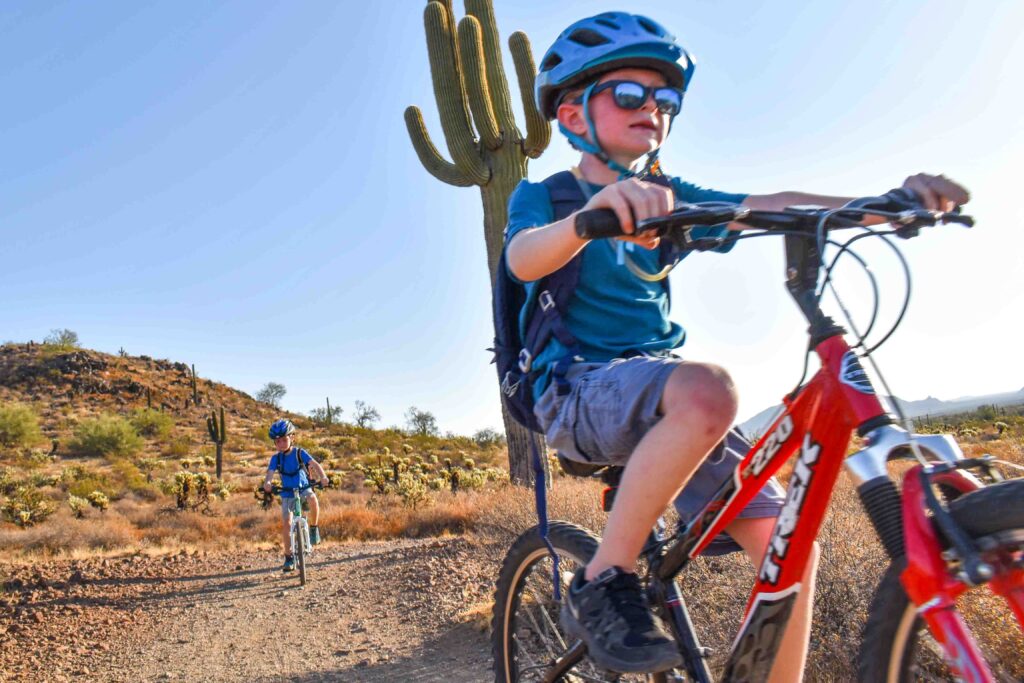
Here’s Everything You Need to Teach Your Kids About Biking Safety!
What is Biking Safety?
Biking safety includes everything from personal bicycle safety gear and ensuring bikes and equipment are in good condition to following rules for public spaces and traffic laws. For kids, some of the most important first lessons are what to wear when biking to protect them in case they fall, and how to safely bike on sidewalks and around neighborhoods.
The rules set for biking on walkways and in neighborhoods can vary depending on where you live. In general, though, there are a few basic principles to go by to ensure your kids stay as safe as possible.
Let’s cover bike safety gear and biking rules separately, below.
What Biking Safety Gear do all Kids Need?
Helmet
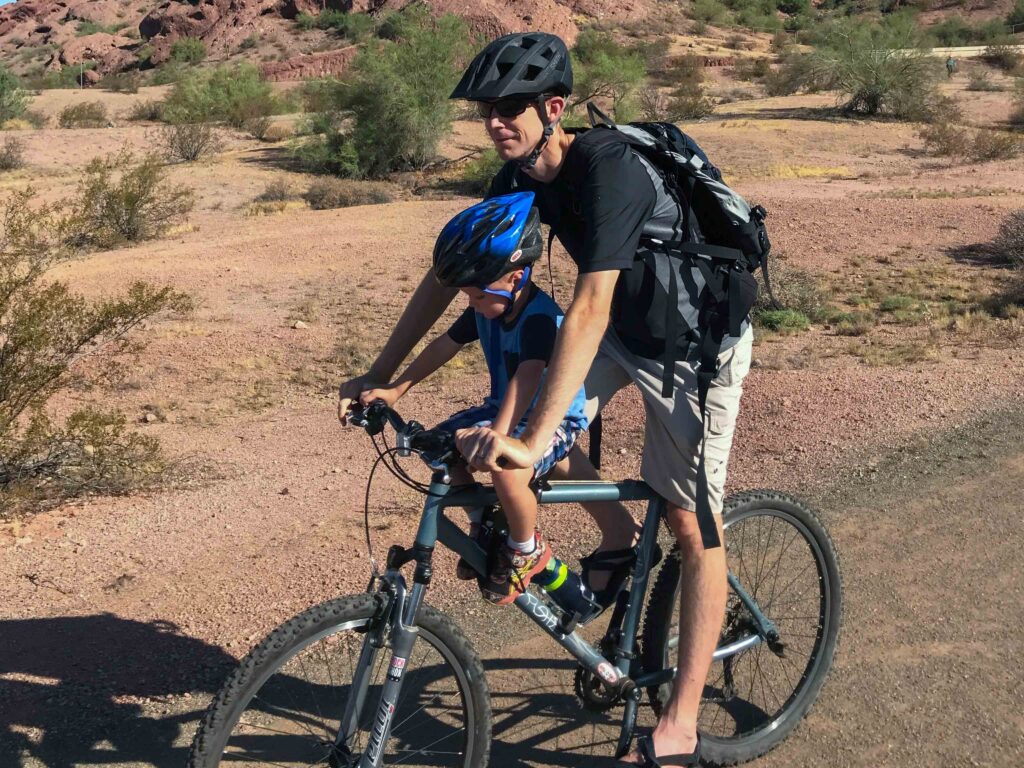
When it has to do with biking safety for kids, even adults the most important piece of bicycle safety equipment is the bicycle helmet, of course! Over recent decades, tremendous research has gone into understanding how to construct a bike helmet to offer the most possible protection in the event of an accident. If you want a more in depth idea of what helmets might be right for your kids, make sure to check out our article on bike helmets for kids. The industry standard for bike helmet engineering is MIPS.
MIPS bicycle helmets protect against several different types of head injuries by understanding the point of impact and creating the best structure and padding to break the fall. When you are looking for a bike helmet, make sure it is MIPS standards. Also check your state laws for bike helmets, because some states require more protective gear than others.
When you are biking with your kids, it’s a good idea to wear a bicycle helmet yourself, When kids see that you’re wearing a helmet, It is more likely that they will wear theirs as well. You can also have a conversation with them about the importance of wearing their biking helmet.
Read Also: Bike Helmets for Kids
You can teach your kids how to put on and buckle the helmet and show them how to check that it’s on correctly.
A properly fitting helmet will be snug but not too tight, and the straps will fit comfortably under the chin with just a one or two-fingers of space between the strap and chin.
If you can begin teaching your kids these important steps, it can encourage them to put on the bicycle helmet by themselves!
Recommended Read: Bike Helmet Laws State by State

Shoes
Proper footwear is the key to any sporting activity, and biking is no different! Shoes should be properly fitting, and ideally closed toe and heel. Avoid wearing anything with loose ends, as these things can get caught in the gears and cause an accident.
The right shoes can help protect your kids from sticks, stones, and general debris that they can roll by on their bikes. It will also help them use their strength and power to its maximum. A snug shoe will give them the stability they need to push and pedal, and stop to balance, or even catch themselves if they’re falling over.
Encourage your kids to wear proper shoes when they go out biking. You can explain to them that a good shoe will actually help them bike better! And again, if you’re setting an example by wearing the right shoes, your kids will be much more likely to follow suit.
Clothing
The right clothes usually depend on the weather. Summer days call for shorts and short sleeved shirts. Whereas early spring or late fall bike rides will require a few more layers. In any event, the clothes should be well fitting and provide good coverage. Even a light pair of pants can help prevent unnecessary scrapes.
Another key thing to remember when dressing for bike rides is to choose brightly colored clothing. A bright red, yellow or orange top will help others on the sidewalks and roadways easily see your kids biking. If you’re biking in low light conditions, it’s also worth considering wearing a high visibility vest that can reflect light for cars to easily see.
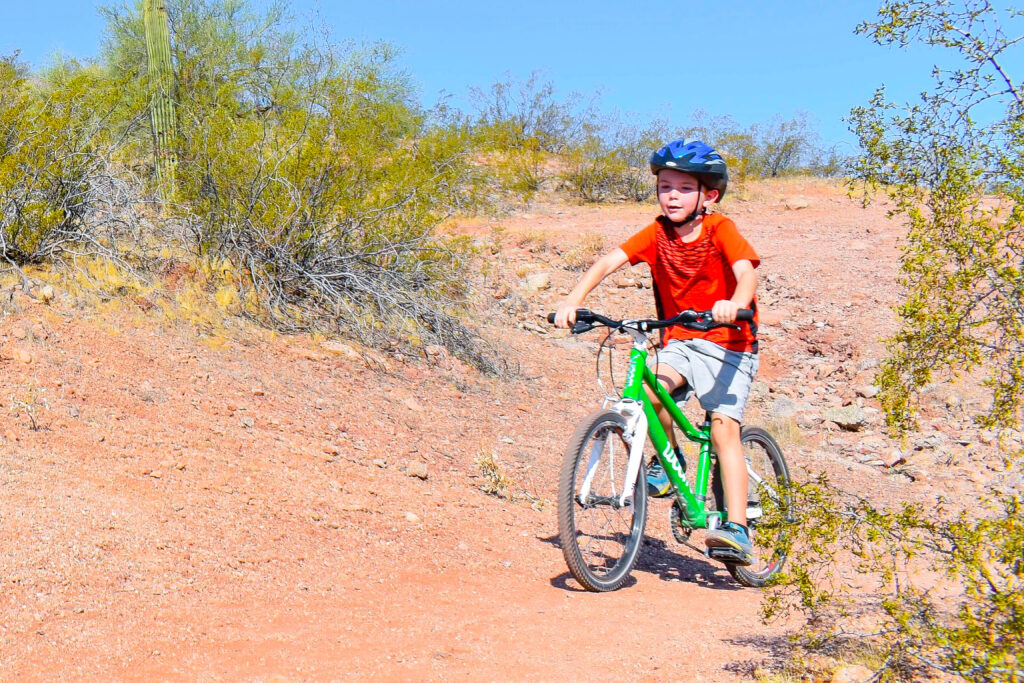
Accessories
There are several accessories that you can add to improve your kids biking experience and safety, as you need them. Biking gloves, for example, can be useful for adding grip for your kids to more easily balance and steer. You can also add knee and elbow pads for kids who are just learning how to bike and are experiences their fair share of tumbles.
Read Also: Best Bike gloves for kids
Adding accessories directly onto the bicycle is a great idea for improving safety! For example, adding a bell or horn will allow your kids to notify people they’re passing by and can teach your kids valuable skills in sharing the roadways with others.
Reflective lights are also a great idea for bike rides that happen in low-light situations. And of course, there are the old-fashioned training wheels that you can add onto most pedal bikes. But with balance bikes, training wheels are fairly outdated.
And finally, it is always worth double checking that the bike is in good condition. You can check the tire pressure and refill when needed, and you can make sure nothing is loose, wobbly, broken, or rusting. Ensuring that the bike is in good condition before rides will help keep your kids safe. You can even teach them how to check their own bike and go over the steps together!
Recommended Reads: Best bike water holder for kids
Biking Safety when Riding on the Sidewalk
Make sure you stay close to your kids. Sometimes it’s a good idea for one parent to bike ride in front while the other rides behind. As you’re biking on the sidewalks, make sure to give pedestrians lots of notice and space when you’re passing by. You can either use your voice, a bell, or a horn to let them know you’re coming up behind. Typically, it’s best to pass people on the right whenever possible.
When you’re on the sidewalks, you’ll most likely need to cross intersections. The best practice is to always stop before the sidewalk ends and dismount from the bike. After checking both directions for cars and ensuring that you have time to cross, you can safely walk your bikes to the other side of the road. At the other side, you can then hop back on and continue your journey!
Walking across the road helps ensure that other drives see that you’re cross. It can prevent any accidents from losing control of the biking or taking a tumble in the middle of the intersection. By slowing down and walking across, you will help yourself get across safely while allowing other people to easily see you on the road.

Bike Safety when Riding on the Road with Kids
There are a few key rules you should keep in mind and teach your children. In general, bike riding on the road means following the same traffic laws as any other vehicle on the road. Here are a few important ones to remember:
Ride in the Same Direction as Traffic.
First, make sure you are bike riding in the same direction as traffic. That’s normally on the right side of the road, in North America. It’s a good to encourage your children to ride as far to the right side of the road as possible. And ideally, have your kids riding in a position that allows an adult to see them at all times.
Read Also: Best road bikes for kids
Stop at Intersections and Look Both Ways.
Teach your kids to always stop at intersections and look in both directions to make sure it’s safety cross. This is especially true at stop signs and traffic lights. It’s important to slow down to make sure it’s clear to cross, but also to allow other drivers the chance to see you on the road and give you the proper space you require.
Pay Attention to Unexpected Cars from Driveways.
Depending on the area that you’re riding, you teach your kids to pay attention to cars that are driving out of driveways. Keeping an eye open for unsuspecting cars is a good way to stay ready to avoid them!
Understand Signage and Road Markings.
Depending on the roads you’re riding on, there are designated bike lanes. You can teach your kids the meanings of some basic signs, and how to follow the paint marks on the road. Sticking within the lines on the road, whether on the sidewalk or at intersections, will help keep your kids out of the way of traffic.
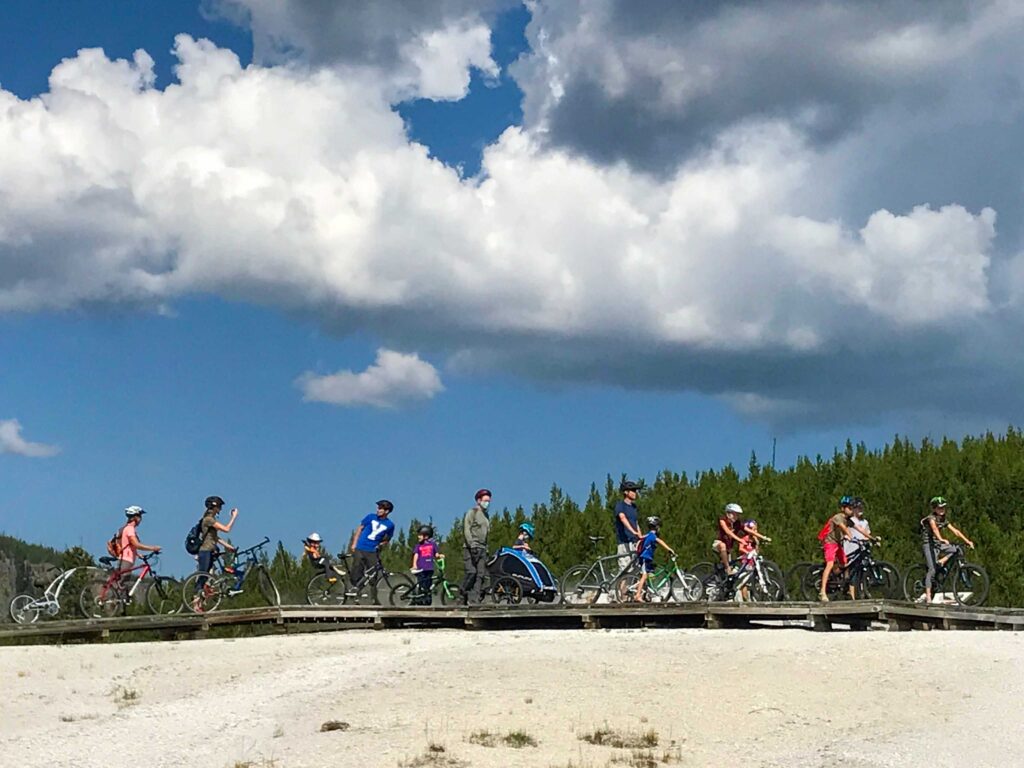
Communicate Your Next Move to Other Drivers.
As a cyclist on the road, you are required to obey the same traffic laws. You must also be extra careful and aware when making turns. It’s best to communicate your intentions as often as possible on the road. There are a few universal hand signals that can help other bikers and drivers know what you’re about to do.
Hand Signals to Use when Biking
Now, you are usually trying to tell your kids to keep both hands on the handlebars. But in this case, you might want to teach them when they should take a hand off the handlebar to give a universal sign for their next biking move.
Recommended Read: Mountain Biking 101 for kids
It’s best to teach this to kids who are confident and able on their pedal bikes, so that they have the strength and control to take one hand off the bike.
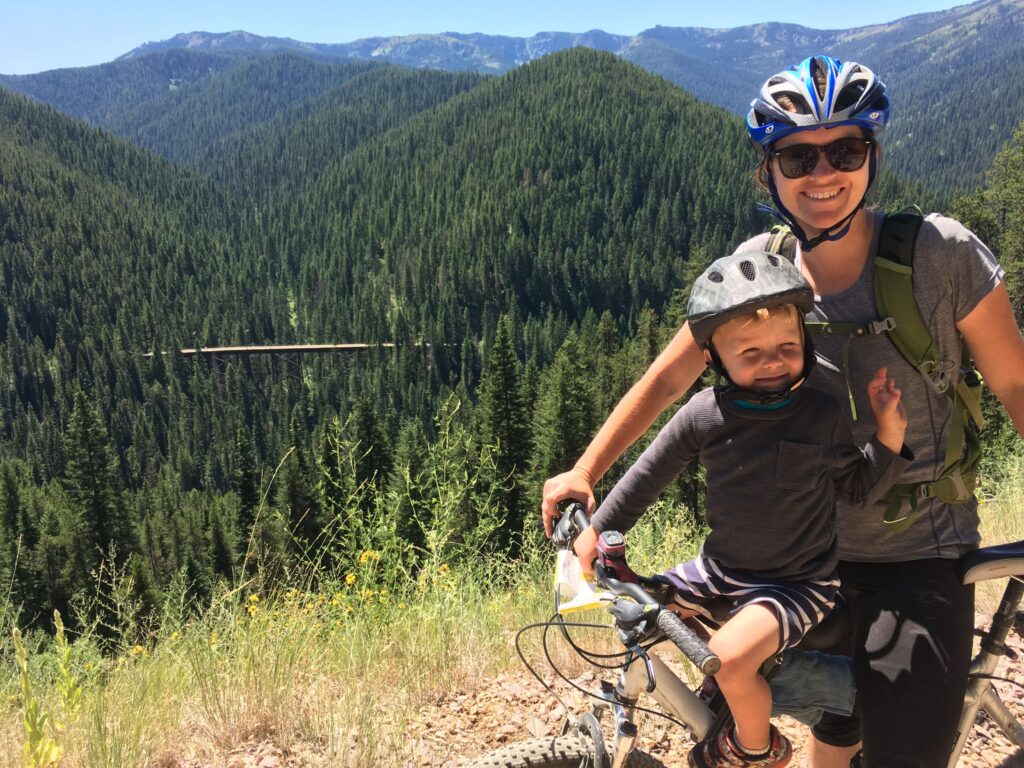
Here are the Key Hand Signals you’ll Want to Teach Your Children:
Since you should always be riding your bike with traffic on the right side of the road, that means that your hand signals should always be presented using the left hand.
Turn Right: Use your left arm and extend it out to the side. Bend your elbow so that fingertips are pointed to the sky. Hold this signal for a few seconds to allow other drives to take notice.
Turn Left: Use your left arm and extent it out to the side. Keep your arm straight so that fingertips are points straight out to the left side. Hold this signal for a few seconds to allow other drives to take notice.
Stopping: Use your left arm and extent it out to the side. Bend your elbow so that fingertips are pointed to the ground. Hold this signal for a few seconds to allow other drives to take notice.
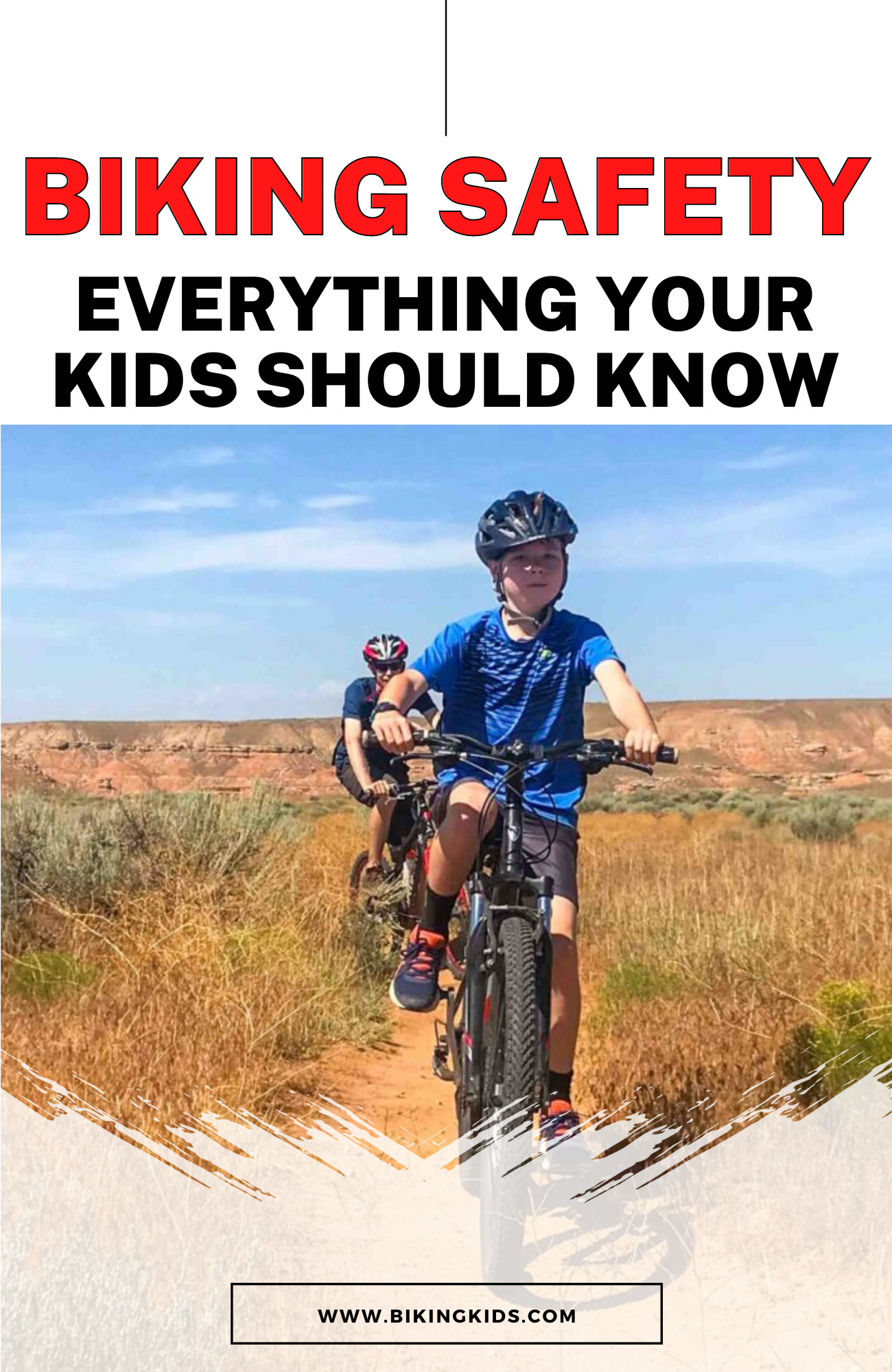
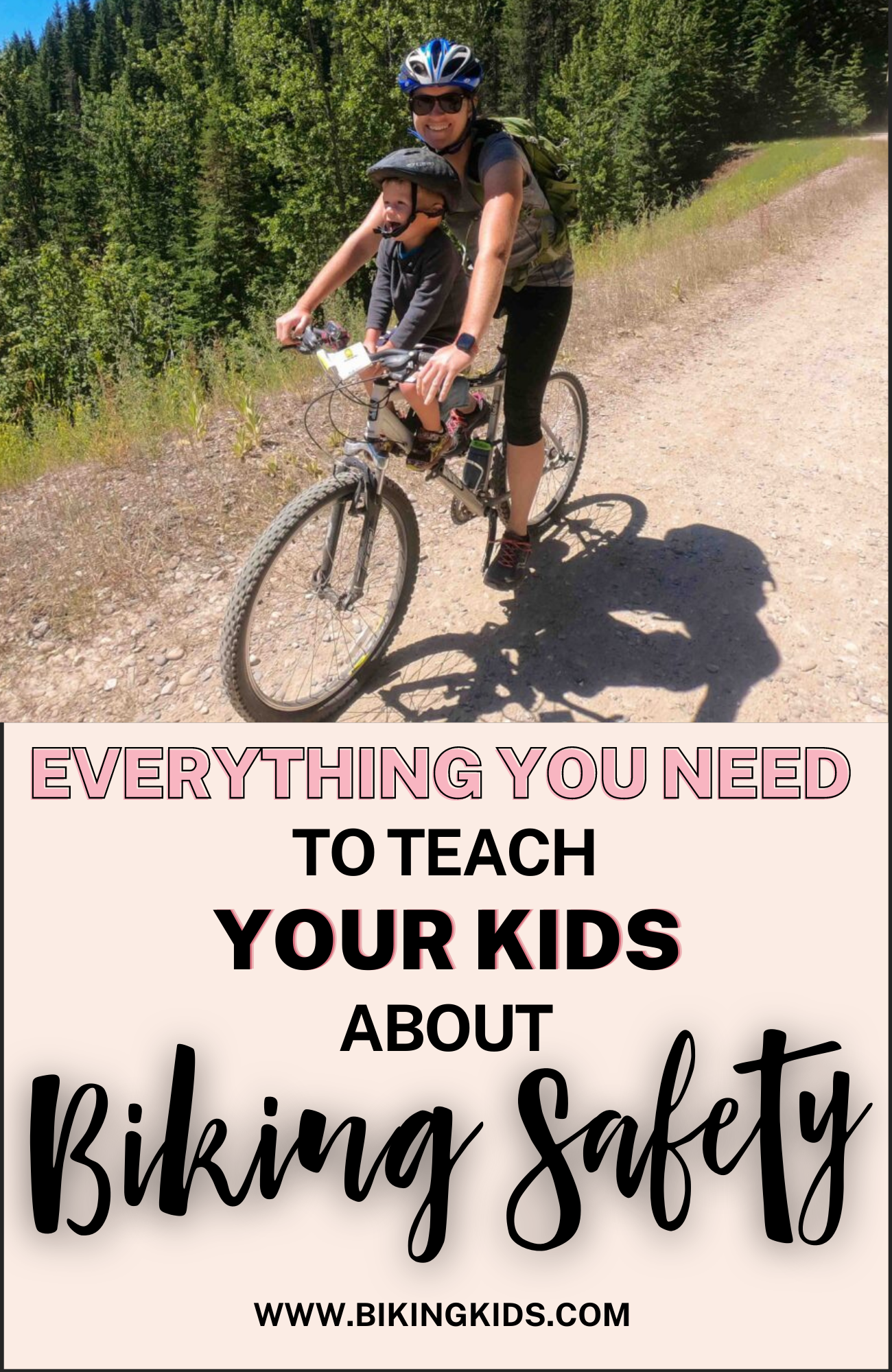
Read Also:
Did we miss something? What safety tip on our list is new or surprising to you let us know in the comment below.

